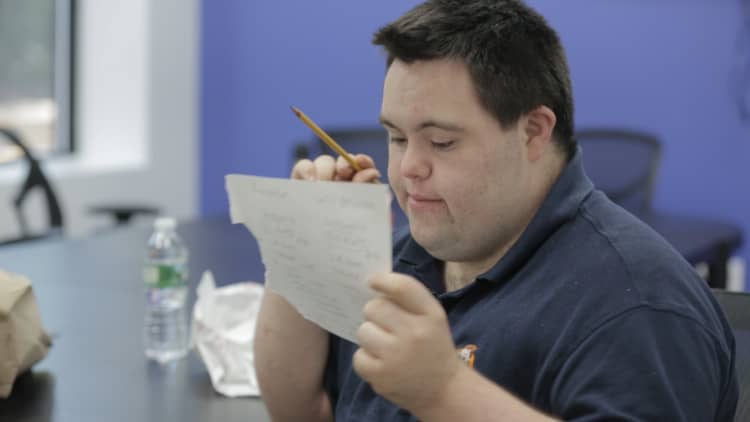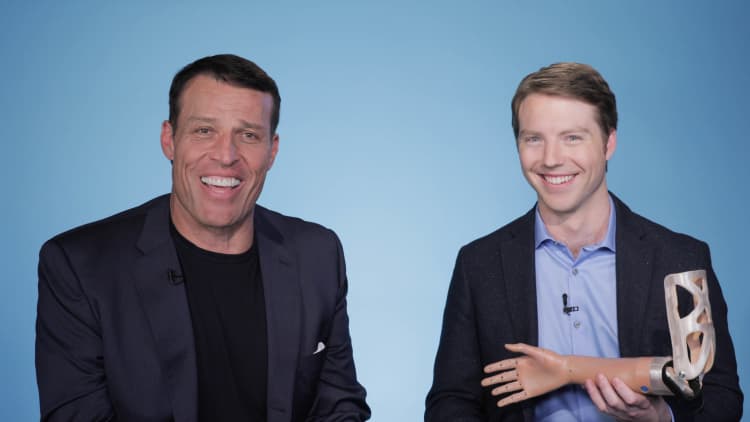At 23, Easton LaChappelle has been called "the next Elon Musk" by none other than Tony Robbins. Those are great expectations to set for any young person, but LaChappelle is no ordinary entrepreneur. The inventor is trying to make prosthetic devices more affordable using 3D printing, and he's already made impressive progress.
LaChappelle has always loved to tinker with electronics. Growing up in rural Colorado, he taught himself the basics of robotics using YouTube and by Skyping experts around the world. At age 14, he built his first working robotic hand using LEGOs, fishing wire and electrical tubing.
For his 16th birthday, LaChappelle got a 3D printer, which "enabled a whole new world of creation," he tells CNBC Make It. The teen printed a robotic arm, powered it with a windshield wiper motor and submitted it to the 2012 Colorado State Science Fair.
During the public viewing at the science fair, LaChappelle noticed a girl scoping out his project. "She was focused on so many small details and that caught my eye," he says. "I realized that she was missing her right arm and was wearing a prosthetic device. This was the first time I really saw a prosthetic device and was really able to talk to an amputee."
The girl's prosthetic was, he says, a "simple, human-like claw" with just one motion — it could either open or close. Still, it cost a fortune: $80,000, he learned after talking to her parents. As she grew, her family would have to shell out hundreds of thousands of dollars to keep replacing the device.
"It's like having to buy an $80,000 pair of shoes," says LaChappelle, and that "blew me away. It motivated me to really take this to the next level."
LaChappelle's bedroom became "pretty much a lab with a bed in the corner," he says, where he worked to turn his prototype into a practical, affordable device. "At one point I had three, 3D printers running 24-7 in there. I had a main desk where I would solder and write software. I had a fabrication bench where I would use power tools like Dremel tools, saws, grinders and drills."
Later in 2012, he brought his same robotic arm to the International Science and Engineering Fair, the world's largest international pre-college science competition, and took second place in the engineering category. "That put me on a lot of different radars," says LaChappelle.
He started traveling the world for speaking engagements and was invited to intern with NASA to work on the Robonaut, a humanoid robot designed to work side by side with humans in space. He even got an invite to the White House, along with other young inventors, and showed his project to President Barack Obama.
In 2014, bestselling author and business strategist Tony Robbins took notice. After watching a TED Talk LaChappelle gave about 3D printing in animatronics (aka, life-like robots) the self-made millionaire reached out.
"I called him up, had this conversation and realized he is one of the smartest, at any age, people in technology," Robbins says. "This is the next Elon Musk and then some."
LaChappelle was 17 at the time and about to graduate from high school. "This was a really big moment for me," he says. "I was trying to decide: Do I go to college? Do I try and start a company myself and self-fund it? Do I go and find venture capitalists?"
The phone call from Robbins, who wanted to partner with him, made the decision easy: LaChappelle decided not to apply and forewent college to continue building robotic arms. He launched his company, Unlimited Tomorrow, with Robbins in February 2014.
This is the next Elon Musk and then some.Tony Robbinsbestselling author
"He provided investment, mentorship and guidance to be able to go from a bedroom in Colorado to a garage to a facility, [and] to be able to start working with big companies," says LaChappelle.
Besides joining forces with Robbins, who has invested $150,000 in the company, he has partnered with major industry players like Microsoft, the software company Dassault Systèmes and Arrow Electronics, all of which help make the product better, he says.
Today, Unlimited Tomorrow is valued at $10 million, he says. He serves as CEO and has seven employees.
In June 2017, LaChappelle put the first of his company's robotic arms on a 10-year-old girl named Momo, who lives in Florida and was born without a right forearm and hand. Scans helped LaChappelle make the device a mirror image of her left arm, down to finger length and width. Since the devices are 3D printed in color, hers even matches her skin tone.
"Each joint is independent, so you don't have to think about, 'How do I have to position my hand to grab a glass of water?'" explains LaChappelle. "You just do it. It's second nature. It's human-like." The device is also smart enough to recognize how much force it's exerting, so it won't crush an egg it's holding, for example.
The technology is comparable to what is currently available in the market, according to Dr. Marlis Gonzalez-Fernandez, associate professor of physical medicine and rehabilitation at The Johns Hopkins University School of Medicine. "Currently available prosthesis can be fabricated to match skin color, have independent joint movement, etc.," she says.
But the fact that the device is 3D-printed is a welcome innovation — it makes the arm more lightweight, Gonzalez-Fernandez says, which is "an asset."
"The most important difference is that they propose to significantly reduce cost while providing a high performing device," she adds. "This can be really important to make prosthesis more accessible to people with amputations."
LaChappelle wants to sell the prosthetic arms for $5,000-$10,000 and is "working on ways to reduce this further," he says.
Part of the reason prosthetics are currently so expensive is "because there's very little competition and [companies] can price it at whatever they want," he says.
"Up until now, it would be nearly impossible to even make a product like this without millions of dollars and a full team. With 3D printing, it allows a small company like ours to innovate and use the parts for final production."
The most important difference is that they propose to significantly reduce cost while providing a high-performing device.Marlis Gonzalez-Fernandezassociate professor of physical medicine and rehabilitation, Johns Hopkins University School of Medicine
Currently, "most prosthesis are modular," Dr. Gonzalez-Fernandez explains. "They are built by putting together a custom-made socket (the part that attaches to the limb) with other components that are commercially available. ... The cost of the prostheses is directly related to the cost of the components used. Joints, feet and hands can be expensive and are generally more expensive the more high-tech they are."
LaChappelle's two main competitors in the prosthetic space are Bebionic and Össur. CNBC Make It reached out to Össur, which declined to comment on the cost of their prosthetic solutions.
"There are many factors, such as the patient's health, functional level and residual limb anatomy, which will impact the configuration and cost of their prosthesis," a spokesperson for Össur said, adding: "We do believe that 3D printed prosthetics may have some potential future applications. However, the technology is still in relatively early stages of development, and important clinical issues such as functionality and durability are yet to be proven."
Dr. Gonzalez-Fernandez is optimistic about LaChappelle's 3D-printed robotic arms: "Overall, the proposed device is promising and has the potential to have an important impact especially for those with limited resources. Ultimately, the choice of a prosthesis and the components is dependent on the user's specific needs and their life-goals."
After giving a robotic arm to Momo, LaChappelle and Robbins have been focusing on providing customized devices to 100 more adults and children around the world with amputations or limb differences. They launched a "100 Tomorrows" crowdfunding campaign in November 2018, with the goal of raising $500,000, so that they can give away all 100.
LaChappelle is looking to bring his product to market after the "100 Tomorrows" campaign, in 2019 or 2020. After that, he says, the plan is to "scale into the thousands and tens of thousands and really make a big impact."
Don't miss: These entrepreneurs won time with Tony Robbins at his Fiji resort—here's what they learned
Like this story? Subscribe to CNBC Make It on YouTube!




